
In Part I of the Anthony Rendon scouting report I covered the basics of his swing and all around game. But I wanted to write a second article on him to further break down his actions at the plate and how they help make him successful.
The key word of today is "sequencing". Movements and actions are good, but without proper sequencing, the mis-timing of the actions and movements can create a plethora of contact issues as well as other problems.
So without further adieu, here's Rendon's swing again, in all it's efficient glory.
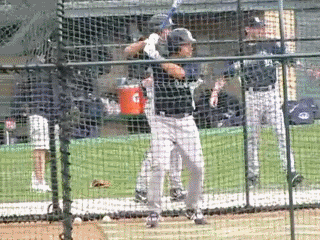
As I said before- Great googa-mooga!
Since Part I covered the bulk of his swing, we can use that report as the description template. This report is to dig deeper into his swing to try and try to explain and try to explain: 1) what's there 2) why he does it and 3) if his actions pose a risk... (Spoiler alert- not really.)
Technically, one could call Rendon's swing a "two-part/move" swing, or even a "three part/move" swing if you include the launch. But for this portion, we'll focus on the first two moves that lead into launch. Generally, multiple move swings are not something to strive for. They often are a big sign of inefficient movements, or a player's mechanics are off and they are searching for the bat speed they are having trouble creating. And sometimes, you get a combination of the two. Ideally, you never want to have an inefficiency or a search for bat speed in your swing, as this often lead to big problems against advanced pitching. Bat speed should come naturally from strength, mechanics, and efficiency.
But the difference between Rendon's swing and most other "two-move" swings is that the breaking up of the moves not only are necessary for what he's trying to accomplish, but end up working together very well. It all lies in the sequencing and each movement having it's own time and place to happen, but still properly leading into the next action without any hiccups.
Let's take a look at the first part of Rendon's swing, the gather portion.

The would be technically defined as the first "move" of his swing.
As you can see, he starts with his front foot open and his barrel behind his head. At the same time he tips his barrel forward and out in front of his helmet while striding back to a neutral position with his front foot and landing on his toe. This would be his loaded or "gathered" position. Take note of Rendon's rear leg once the clip pauses. That is rock-solid rear leg to launch his swing from, which is a super important position that tells his his rear hip is loaded and his body is ready to attack.
Rendon's choice of tipping his barrel to get it moving and create early bat speed -- read, free bat speed -- while bringing his front foot toward the plate into a neutral position is an efficient manner of getting to a locked, loaded, and balanced position. This is arguably the most important position for any hitter to get to. Without it, you'll either be late, weak to the ball, or both.
From this position, Rendon can go and get to any pitch in almost any quadrant of the strike zone. He is on balance and in a rock solid position from which he can punish any poor round object thrown his way.
While most other players do this move seamlessly as part of their actions, Rendon has chosen to break them into two parts. And because he completes these actions in separate moves, he allows each action to have it's own importance.
Now let's take a look at the next portion of his swing, the trigger and final stride.
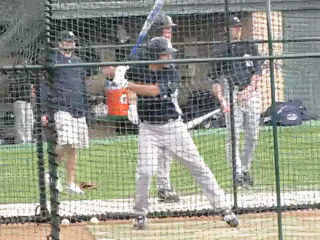
This clip picks up right where the second one left off.
Now we can see Rendon's hand raise trigger as his front foot finishes the last part of his toe-tap stride. This hand raise trigger is when Rendon launches his swing, and tells us that it is a hand oriented swing. No, not that the hands are supplying power -- they supply quickness -- but that Rendon is swinging with "educated hands". His hands are relying on the body to supply the power and bat speed, but Rendon's hands have a clear goal. And that goal is to get flat, get forward quick, find the ball and then ruin pitcher's egos. No turning into the ball with dead fish hands and hoping the barrel happens to run into the oncoming pitch here.
One thing that stands out in this second Rendon clip pertains to Rendon's lower body. He got to his important "gathered" position with the first move, and the second move not only contains the hand raise trigger, but also a smooth and efficient rear leg push forward. This slight -- slight is key, too much of a push can create hip slide and/or timing issues with the pitch -- rear leg push helps give his rear hip some extra oomph to move forward with. Rendon doesn't have to rely on brute force hip rotation to power through the ball.
The rear leg push helps him have a quick yet still powerful rear hip drive into the baseball. This rear leg push also handles Rendon's stride as well. Instead of trying to gain ground with the front foot and possibly over striding or landing in an unbalanced position, Rendon's rear leg push moves his front foot forward and keeps his weight distribution and balance where it needs to be.
So not only does his barrel have a running start, but his lower body has a running start as well. Still any question to why he's so good?
But for a better look at move number two, here it is slowed down so we can clearly see his hand actions and take a gander at how the sequencing makes it all tie together.
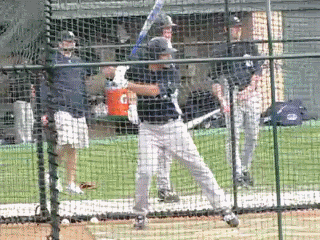
Here we get a clear look at Rendon's hand raise trigger. Now, to quickly quell any questions as to whether such a trigger can be trouble some at the Major League level, here's a rather famous hitter with similar hand actions-
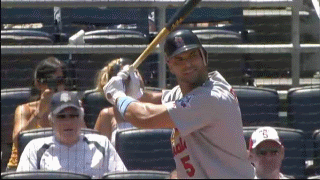
As we can see in both Rendon and Pujols, a hand raise trigger is a great way to have active hands from the very beginning. Active hands are the key to quickness and barrel control, and both hitters have those two assets down pat.
Remember the Hank Aaron clip from Part I?
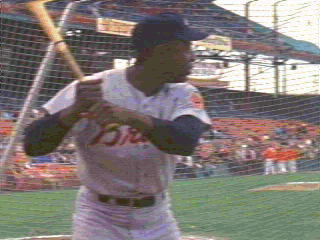
Same principle. Notice how all three hitters get their hands flat immediately at launch? Notice how the all get forward very quickly and easily? That's the benefit of this move. Excellent plane matching with the pitch, squaring of the baseball, and supreme quickness and efficiency.
Back to Rendon, his hand raise trigger helps him be very quick forward into contact with his hands. This keeps his swing from becoming long and helps it stay compact. Rendon's hands and body are working together in unison, and there is no bleed of power or energy once he launches his swing. Everything he's gathered is still there and ready to attack the baseball.
The last thing that helps Rendon get his hands forward quickly and keeps his swing effort levels low is the timing of the stretch of his upper body. The barrel tip from move number one loads his barrel and helps get his body into the "gathered" position, but it's the hand raise trigger in move number two that stretches his upper body back and helps him release the energy Rendon has gathered up into the ball. This late stretch helps him effortlessly fire his gathered energy forward. Think of the late stretch as a second gear. When the hands achieve the late stretch, the upper body gets shifted effortlessly into a more powerful power band. This helps further create easy and efficient movements.
And here's Rendon's full swing again.

Now we can see why his actions are there and why the tiny pause between load and trigger not only serves a purpose but helps him maintain optimum sequencing. Rock solid rear leg to launch from, balance, timing, a tipped and loaded barrel, effcient hand raise trigger, supreme quickness forward with flat hands... I said it once and I'll say it again. Great googa-mooga!
Gaps in actions can lead to problems for some players,but in Anthony Rendon's case, when the gaps are a part of a proper sequencing of movements, the gap can actually tie together and improve his actions. Two examples of Major Leaguers with multiple move swings would be Jason Varitek and Travis Hafner. But just like Rendon, both Varitek and Hafner have their "gaps" timed correctly to interface with the proper sequencing of movements.
Of course, there is some length in Rendon's swing and any time there is an aggressive trigger in one's swing it can lead to holes up and in on hard fastballs. But he only turned 20 years old on June 6th. He has limited experience with wood bats and has plenty of time to fill out and strengthen his grip and forearms. With time, physical maturation, and experience, Rendon's swing should become shorter and shorter while also becoming more efficient -- a frightening thought).
Rendon isn't the biggest fish in the pond, but with this kind of proper sequencing, he is extremely efficient in his mechanics. He doesn't need otherworldly strength to be dominant. Rendon's talent and mechanics take care of that for him. No prospect is a lock to be a star, but Rendon's chances are just about as good as anyone's.
Follow Steve Carter on Twitter or reach him at stevecarterpp@hotmail.com
